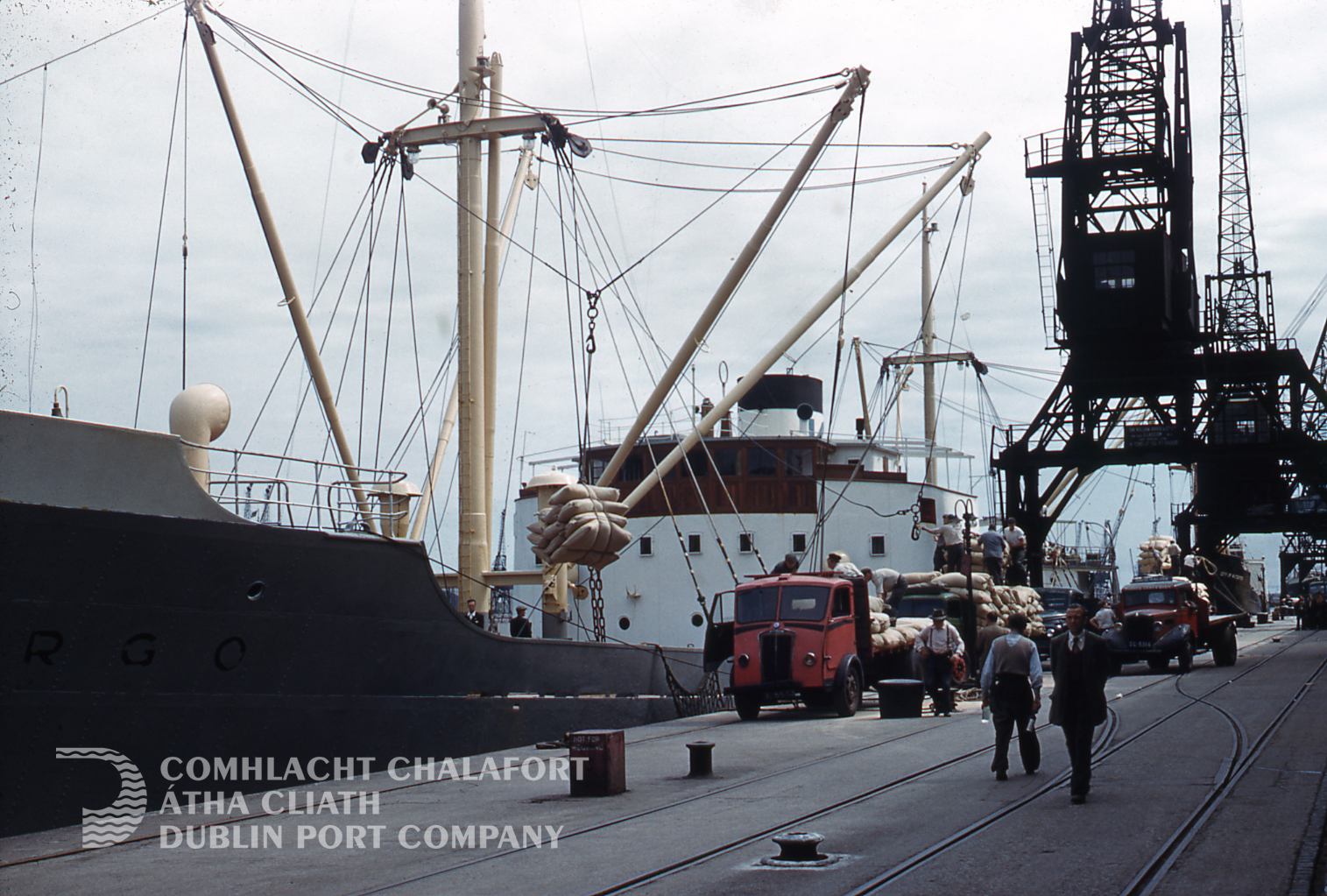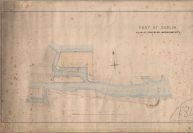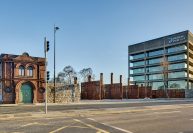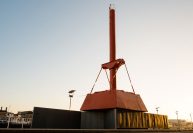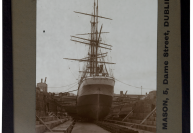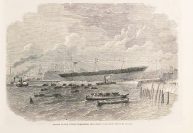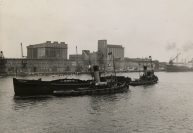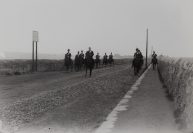Restoring the Former Electrical Substation
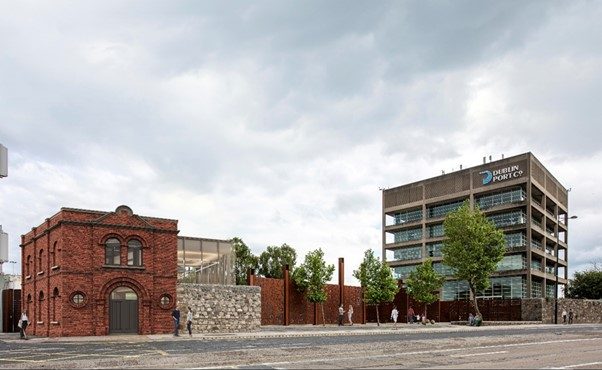
Restoring the Red-Brick Substation adjacent to Port Centre may appear a small project in terms of its physical size, but it is one of the most complex and rewarding aspects of Dublin Port Company’s Port/City integration projects.
The restoration and redevelopment of the former electrical Substation on the corner of East Wall Road and Alexandra Road may be a small project in terms of footprint but it is amongst the most challenging and rewarding of Dublin Port Company’s recent Port/City Integration projects.
Originally slated for demolition in 2016, the former ESB Substation is now a protected structure, whose historic value has been recognised and valued and is the subject of an ambitious restoration, which will see the original two-storey redbrick building made secure, increasing to double-height as the first floor is removed, and eventually being joined by a completely new, mostly glass extension, a double-height Lightbox which will effectively double the building’s footprint. The project includes some interesting architectural and historical features both above and below ground.
“It is a relatively small site but a very complex project,” smiles Jim Kelleher, Head of Special Projects, Dublin Port Company, Port Heritage & Communications Group. “I was very relieved to get the work started on-site because there was a long lead-up to this. The building was at risk of collapse or demolition back in 2016. With the vibrations from the amount of traffic going by, along with significant adjacent works at Port Centre Precinct, something had to be done or the building was going to collapse. In terms of footprint, it is small, but in terms of effort, this is an important project for us. The goal of uncovering the original 18th Century sea wall that gives the East Wall its name would be special.”
The modest scaled decorative redbrick Substation forms the cornerstone of Port Centre Precinct. While its exact date of construction is unknown, the latest estimates suggest that it was built around 1908. This two-storey, red brick, nearly rectangular-shaped building has two formal “show fronts” facing the public roads (East Wall Road and Alexandra Road), with two-port hole windows either side of the arched front door, with really nice brickwork and craftsmanship. It was decommissioned during the works of 2017-2018 and was in a critical condition structurally when consideration of this project began.
“This building is like a helicopter; it just wants to fall out of the sky and crash to the ground,” laughs Tim Darmody from Darmody Architecture, lead architect of the project. “The building’s western wall is built on the old historic quay wall and is relatively strong but the other three walls want to fall down, due to a combination of bad ground and vibration from the amount of traffic over the years. So there is an awful lot of care and love going into restoring the original building and bringing it back to its great self.”
Making the Building Safe
Before any work could begin on restoring the building, however, it had to be made safe. To that end, raking shores were put in position to support the walls and the building’s exterior was also wrapped in a steel exoskeleton.
“Before we remove any of those, we will put a new steel skeleton structure inside. We have designed quite a refined structure inside, which will do the job that had been done by bracing the outside of the building,” reveals Tim, who explains that due to the building’s age, its measurements are a far cry from the straight lines and plumb edges of today, meaning that every part of that internal design is bespoke.
“When our internal skeleton structure is in place, we will remove the exoskeleton and raking shores and the building will stand, and only then will we be able to proceed working on the new glazed structure,” Tim notes, explaining how they want the glass façade to be “as clear and non-fussy as possible, noting how they brought façade consultants on board, who Tim describes as “one of the top façade and glass consultants in Europe”.
“The façade consultants brought a lot of science to the process, allowing us to use seven-metre glass panels in a structure that is not just beautiful but functions in the way we want it to function and not to overheat, for example,” Tim adds. “There were a lot of considerations to take on board to create what will end up looking like a relatively simple, refined structure. When we are finished, we want to smell some of the oil of the old transformers and see the grit of the old Substation, but alongside that we will have a contemporary glass box to allow as much transparency and offer clear views into the Substation itself.”
The impressive span of glass will allow the original red- brick structure to be revealed as much as possible. “The double height space will really allow people to see it
and what it’s all about, while we conserve the beautiful brick elevations on the outside,” Jim notes. “The glass extension will add hugely to the usable space and will allow the space to seat up to 60 people for an event.”
Another challenge which complicates the project is the amount of underground cabling which passes beneath the structure, cables which are vital to the running of the Port. “There are as many challenges below ground as there are above ground,” Tim admits.
Revealing the Original East Wall
While the moving of the cabling is not something the public will ever be aware of, there will be innovations evident beneath the ground, as well as above it. The Substation marks where the City stopped at the east wall until 1850, and the team plan to uncover the original east wall in the basement, to unveil part of the city as it existed 170 years ago.
“We are trying to excavate down to expose the original sea wall,” Jim notes. “Our archaeologist did a ‘Time Team’-type GPR survey to try to locate the original wall and we would like to have part of that wall visible to the public and tell its story of enclosing the lotts and the East Wall area from the sea, as well as the advent of electricity in the Port a century and a half later.”
Tim believes that this part of the project will be particularly exciting for visitors: “For hundreds of years, ports not just in Dublin but around the world were hidden away behind huge walls. But when you pivot it slightly and create a small hole in those walls where people can look through or even walk through, it allows them to see part of the city’s history. In this project with the Substation, we’re going to allow them to see part of the quay wall that dates back almost 200 years and was lost below ground and built over, so it also tells the story of the evolution of the Port as it moved eastwards and reclaimed land.”
Working within the Port for architects often involves treading a fine line between utilising a building’s form to showcase its historical value, while also creating
a building that works for a 21st century audience or function. It’s a challenge that Tim relishes.
“I love the grit,” he laughs. “I love understanding how places like Dublin Port work and the activities that happen there. We do get what the Port is about and respect the function of the Port in moving huge volumes of goods. Also, I think secretly inside of me is an old Victorian engineer, who appreciates these fantastic old buildings.
I think it’s important to understand the activity that was carried out in these buildings and to have an empathy for that activity, and to love these old buildings.”
Creating a Multi-Functional Space
When the project is completed in spring 2023, the Substation will form part of the Distributed Museum concept, similar to the Diving Bell and Crane 292, which are strong visual symbols of the Port and its functions. In many ways, the Substation marks the physical dividing line between the City and the Port and has considerable potential to be an anchor for the entire Port experience. As a multi-functional space, it will host a range of small scale events such as lectures and seminars, poetry reading, music recital, intimate experimental theatre performance, a venue for The Dockers Preservation Society, pop-up café, or a teaching space.
“While the Substation will form part of the Distributed Museum, the value of a multifunction space is it could also be the perfect venue for a book launch, a board meeting, a piano recital or some other form of intimate event. The bringing together of a multi-disciplinary design team that works closely with the client and project sponsors is key to this,” Jim admits
All the working elements of the final building, including toilets, a cloak-room and a pop-up kitchen, will be housed in the new glass area “to allow the Substation to have a clear footprint and to be retained as a wonderful space,” according to Tim.
“Following this project, it will be a building that the public can engage with, maybe see an exhibition there, have a cup of coffee, attend a talk or even present a talk,” Tim summarises. “I think it’s incredible that you have this tiny building with a possible multitude of uses for Dublin Port Company, for the local community, for artists, for visitors to the Port. It is a fantastic touchstone for what this city- port is going to be. Although the Port estate is 500 acres, this modest building will be the first building that is open to the public in that estate and will be one of Dublin’s smallest museums.”
Help us with the Archive
You can help us to preserve Dublin Port’s rich archival heritage by
donating items or seek advice from us on items in your safekeeping.
Get in touch by completing the contact form below.
We’d love to hear from you!
